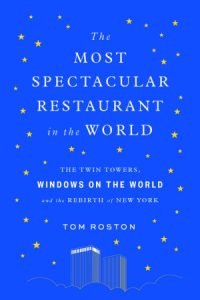Reviews
Booklist – Starred Review – September 15, 2019
Billed as a history of Windows on the World, the 107th-floor restaurant in the World Trade Center that ruled the New York City skyline from April 1976 until September 11, 2001, this engrossing tale delivers much more. In brief, engaging chapters, journalist Roston considers the political, social, financial, and gustatory changes that were shaping Manhattan during that time.
He also relates the never-ending legal wranglings over construction of the towers, and the public opinion that the city itself was filthy, crime ridden, and beyond hope. Legendary feats changed the public’s view on the controversial Twin Towers, including tightrope walks, parachute jumps, and perilous scaling of the outer walls. Some of the most interesting coverage is about the people who shaped the eatery: restaurateur Joe Baum, chefs, sommeliers, food writers and critics, a parade of celebrities, and the greeters, waiters, busboys, sous-chefs, and dishwashers who were critical to the restaurant’s daily success. These employees represented an array of nationalities, locals and immigrants who found job security and opportunities for advancement at Windows on the World; 73 were at work when the plane hit the North Tower. Based on interviews, contemporary media coverage, and scrupulous research, this detailed account will appeal to a wide audience.
— Kathleen McBroom
Kirkus Reviews – Starred Review – August 1, 2019
A detailed, inspiring, and horrifying account of the restaurant that sat atop the North Tower of the World Trade Center. Former Premiere senior editor Roston (I Lost It at the Video Store: A Filmmakers’ Oral History of a Vanished Era, 2015) returns with a rich, complex account of Windows on the World, a story the author begins by discussing the many immigrants who worked there—later, he includes one of Donald Trump’s many clueless comments about 9/11. However, politics is much in the background; in the foreground are the many stories of the founders of the restaurant, the local politics (e.g., dealing with the Port Authority, the organization that controlled the site), key workers in the restaurant, the amenities, and the menus.
He also chronicles the fundamental changes that occurred after the Feb. 26, 1993, truck-bomb episode. Informed by more than 125 interviews, the text is most impressive for its accounts of the human relationships involved, both the friendships and the fiery competitions among some of the managers. Emerging above all is Joe Baum, the original manager, who, writes Roston, “could electrify or freeze a room, depending on his mood.” Baum and his colleagues faced significant challenges in the space. For example, they were not allowed to use natural gas and had to use electricity (which most all disdained) and a charcoal pit, and they were dealing with a rough economy in the mid-1970s.
Eventually, however, the restaurant grossed enormous sums and became a New York City institution. Roston concludes with some very painful chapters about 9/11: the day before, the day of, the days after. All who were in the restaurant died that day; there was no escape from the floors above the impact. As the author grimly reminds us, many on the doomed upper floors jumped, preferring that to incineration. Stories of creation and destruction told in an informed and compassionate voice.

